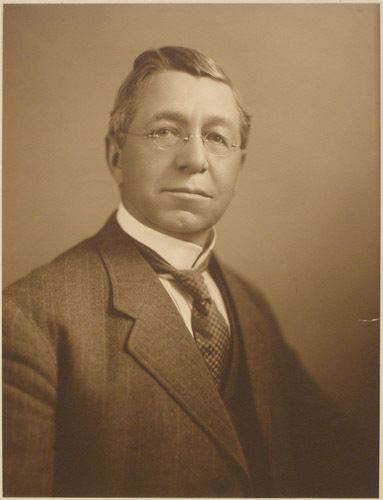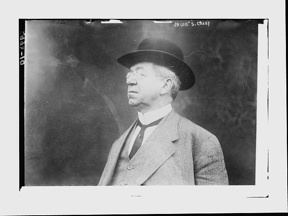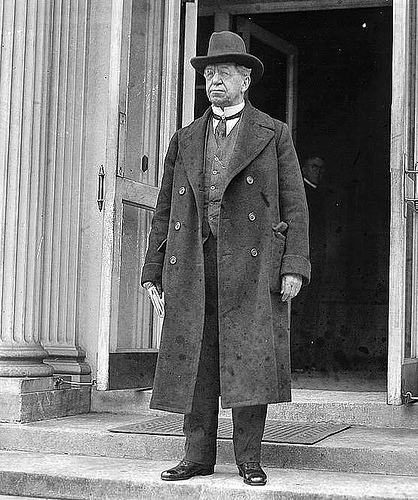Children 8 children Religion Protestantism | Name Jacob Coxey, Role American Politician | |
 | ||
Born April 16, 1854Selinsgrove, Pennsylvania, U.S. ( 1854-04-16 ) Spouse(s) Caroline Ammerman (m. 1874–88); divorcedHenrietta Jones (m. 1900–51); her death Profession Businessman, landowner, political activist Political party Greenback Party, People\'s Party | ||
Jacob Sechler Coxey Sr. (April 16, 1854 – May 18, 1951), sometimes known as General Coxey, of Massillon, Ohio, was an American politician who ran for elective office several times in Ohio. Twice, in 1894 and 1914, he led "Coxey's Army", a group of unemployed men who marched to Washington, D.C. to present a "Petition in Boots" demanding that the United States Congress allocate funds to create jobs for the unemployed. Although the marches failed, Coxey's Army was an early attempt to arouse political interest in an issue that grew in importance until the Social Security Act of 1935 encouraged the establishment of state unemployment insurance programs.
Contents
Biography

Coxey was born on April 16, 1854 in Selinsgrove, Pennsylvania, the son of Mary Ann (Sechler) and Thomas Coxey. His family moved to the industrially thriving Danville, Pennsylvania when he was six years old. Known as Jake, Coxey excelled in school and took his first job at the age of 16 as a water boy in the mill where his father worked.

Coxey spent eight years at the water mill, advancing to stationary engineer, before he left to pursue other business endeavors. In May 1881, Coxey went to Ohio to look at property and decided to stay. He erected a crushing mill and quickly began accumulating wealth.

He was often branded as a crank for challenging the economic system that made him so prosperous. In addition to his 160-acre (0.65 km2) ranch in Massillon, Ohio, he owned ranches in Lexington, Kentucky and Guthrie, Oklahoma.

Coxey was a passionate equestrian. He bred blooded horses and raced or sold them across the nation. Many criticized his sporting propensities and his obsession with the track is often cited as the cause of his first divorce.

Many members of Coxey’s family were opposed to his involvement in Coxey’s Army. His father refused to talk to reporters and called his son "stiff necked", "cranky" and "pig-headed". One of Coxey’s sisters called him an embarrassment.

Coxey lived to be 97 years old. When asked his secret to longevity, he told reporters an array of reasons from elixirs to not resisting temptation.
Personal Life
He was married in 1874 to Carrie Coxey. They had four children before divorcing after 14 years. He married again in 1891 to Henrietta Jones and had two more children. Coxey’s youngest son was named $Legal Tender$, a reflection of his obsession with monetary reform.
Political beginnings
Coxey had experience as a laborer and an employer; he was also aware of the agricultural situation. He was a reformer who was willing to spend time and money to promote his plans for the betterment of the social order.
Coxey was born to Democratic parents. He held his affiliation with the Democratic Party until 1876. As party principles changed, Coxey became a Greenbacker. The Greenback tradition was a movement to put more money into the economy by printing more money. When the People’s Party emerged, it earned the support of Coxey and most other Greenbackers. He was a member of the Socialist Party circa 1912.
Coxey was convincingly earnest. One reporter wrote, "He seems to be profoundly impressed with the suffering of mankind and with a belief that there is a deep-laid plan of monopolist to crush the poor to the earth".
Timeline
1885: Ran as the nominee of the Greenback Party for a seat in the Ohio State Senate but lost in his first attempt at public office.
1894: Led Coxey's Army, a march that started in Ohio, and passed through Pittsburgh in April. Interest in the march dwindled in mid May. Coxey was concerned with the lack of meaningful work, and thus demanded that the federal government provide such for the unemployed. Coxey, his wife, and his son, Legal Tender Coxey, rode in a carriage ahead of some 400 protesters towards Washington D.C. He was arrested for walking on the grass and his army peacefully dispersed. Although it didn't seem to have much effect, the march on Washington and the growing threat of populism at this time struck fear into the hearts of many.
1894: Nominated by the People's Party for the 18th District seat in the U.S. House of Representatives.
1895: Nominated by People's Party for Governor of Ohio.
1897: Nominated by People's Party for Governor of Ohio.
1916: Unsuccessfully ran for a seat in the United States Senate.
1922: Ran as an independent for the U.S. House in the 18th District against incumbent Republican B. Franklin Murphy and lost.
1924: Ran as an independent for the U.S. House against Democratic incumbent John McSweeney in the 16th District, losing again.
1926: Ran for the Republican Party's nomination for the 16th District seat and lost in the primary election.
1928: Again tried unsuccessfully to get the Republican nomination for the U.S. Senate in the primary. In the general election, he ran as an independent for the U.S. House in the 16th District, against McSweeney again (who lost his seat to the Republican challenger Charles B. McClintock). He also received two votes in the race for Frank Murphy's seat. He also ran for President as the candidate of the Interracial Independent Political Party with Simon P. W. Drew as his running mate.[1][2]
1930: Again lost the contest to be the Republican nominee in the 16th District U.S. House primary.
1931: Elected as mayor of Massillon.
1932: Again lost the contest to be the Republican nominee in the 16th District U.S. House primary.
1932: In 1932, unsuccessfully ran for the office of President of the United States on the ticket of the United States Farmer-Labor Party.
1934: Again lost the contest to be the Republican nominee in the 16th District U.S. House primary.
1936: Ran again in 1936 against Democratic incumbent William R. Thom, the successor to McSweeney and McClintock, this time under the banner of the Union Party, and again losing.
1938: Contested for the Democratic Party's nomination in the 16th District primaries and lost.
1941: Unsuccessfully tried to get the Democratic nomination for mayor of Massillon after losing his seat in 1933.
1942: Contested for the Democratic Party's nomination in the 16th District primaries and lost.
